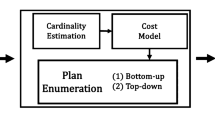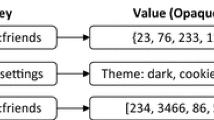Abstract
Cooperative query answering extends the classical notion of query answering to provide neighborhood and associated information. Neighborhood query answering relaxes the query and its answer via abstract representations. To integrate the abstraction view with the subsumption (is-a) and composition (part-of) views of type hierarchy, the notion of type abstraction hierarchy is introduced. To evaluate and control query relaxation, a nearness measure mechanism is provided. Associative query answering provides information conceptually related to, but not explicitly asked by the query. As object association is context sensitive, a DB-Pattern-KB framework is developed that couples domain-specific knowledge and participating objects in localized problem domains via virtual database patterns. Associative query answering can then be accomplished through tracing the behavior dependencies among cooperating objects in those problem domains. Such a framework allows related databases and knowledge bases to be linked dynamically in various contexts yet be maintained relatively independent of each other. The proposed approach has been implemented in the cooperative database system tested, CoBase, at UCLA. Our experience reveals that the proposed techniques are effective for cooperative query answering.
Similar content being viewed by others
References
Abiteboul S. and Bonner, A. (1991). Objects and views.ACM-SIGMOD'91, pp. 238–247.
Ait-Kaci, H. (1986). Type Subsumption as a Model of Computation. In L. Kerschburg (Ed.),Expert Database Systems.
Bancilhon, F. and Khoshafian, S. (1986). A calculus for complex objects.Proc. PODS'86.
Banerjee, J. et. al., (1987). Data Model Issues for Object-Oriented Applications.ACM Transactions on Office Information Systems.
Bosc, P. and Galibourg, M. (1989). Indexing Techniques for a Fuzzy Data Base.Information Systems, 14, 493–499.
Chen, Q. and Gardarin, G. (1988). An Implementation Model for Reasoning with Complex Object.SIGMOD Rec., 17, 164–172.
Chu, W.W. and Chen, Q. (1993). A Structured Approach for Cooperative Query Answering.IEEE Transactions on Knowledge and Data Engineering, to appear.
Chu, W.W., Chen, Q., and Lee, R. (1991a). Cooperative Query Answering via Type Abstraction Hierarchy. In S.M. Deen (Ed.),Cooperating Knowledge Based Systems, 1990, (pp. 271–292). New York: Elsevier.
Chu, W.W., Chen, Q., and Page, T. (1991b). Cobase: cooperative distributed databases.Proc. 6th Brazilian Symp. Databases, (pp. 27–36). Brazil.
Chu, W.W., Hwang, A., Lee, R., Chen, Q., Merzbacher, M., and Hecht, H. (1990). Fault tolerant distributed database system via data inference.Proc. 9th Symp. Reliable Distributed Systems, (pp. 86–94).
Cuppens, F. and Demolombe, R. (1989a). Cooperative answering: a methodology to provide intelligent access to databases.Proc. 2nd Int. Conf. Expert Database Systems, (pp. 621–642).
Cuppens, F. and Dmolombe, R. (1989b). How to Recognize Interesting Topics to Provide Cooperative Answering.Information Systems, 14, 163–173.
Cuppens, F. and Demolombe, R. (1991). Extending Answers to Neighbor Entities in a Cooperative Answering Context.Decision Support Systems, 7, 1–11.
Gal, A. and Minker, J. (1988). Informative and Cooperative Answers in Deductive Databases Using Integrity Constraints. InNatural Language Understanding and Logic Programming, (pp. 277–300). Amsterdam: North-Holland.
Gaasterland, T., Godfrey, P., and Minker, J. (1991). Relaxation as a platform of cooperative answering.First Int. Workshop on Nonstandard Queries and Answers, 2, (pp. 101–120). Toulouse, France.
Helm, R., Holland, J., and Gangopadhyay, D. (1990). Contracts: specifying behavioral compositions in object-oriented systems.Proc. OOPSLA'90, (pp. 169–179).
Hemerly, A., Casanova, M. and Furtado, A. (1991). Cooperative Behavior through Request Modification. Working Paper, IBM Brasil, May.
Kaplan, S.J. (1982). Cooperative Responses from a Portable Natural Language Query System.Artificial Intelligence, 19(2), 165–187.
Kim, W. (1989). A model of queries for object-oriented databases.Proc. VLDB'89, (pp. 423–432).
MacGregor, R. (1988). A deductive pattern matcher.Proc. AAAI'88, (pp. 403–408).
Madsen, O. and Moller-Pedersen, B. (1989). Virtual classes: a powerful mechanism in object-oriented programming.Proc. OOPSLA'89, (pp. 397–406).
Motro, A. (1990). FLEX: A Tolerant and Cooperative User Interface to Databases.IEEE Transactions on Knowledge and Data Engineering, 2, 231–246.
Su, S. (1983). SAM*: A Semantic Association Model for Corporate and Scientific-Statistical Databases.Information Sciences, 29, 151–199.
Webber, B.L. and Mays E. (1983). Varieties of user misconceptions: detection and correlation.Proc. 8th Int. Joint Conference on Artificial Intelligence, (pp. 650–652).
Wiederhold, G., Mediators in the Architecture of Future Information Systems.IEEE COMPUTER, March, 38–49.
Zadeh, L. (1965). Fuzzy Sets.Information and Control, 8, 338–353.
Author information
Authors and Affiliations
Additional information
This research is supported by DARPA contract N00174-91-C-0107.
Rights and permissions
About this article
Cite this article
Chu, W.W., Chen, Q. Neighborhood and associative query answering. J Intell Inf Syst 1, 355–382 (1992). https://doi.org/10.1007/BF00962924
Issue Date:
DOI: https://doi.org/10.1007/BF00962924




